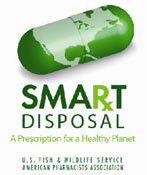 |
| Improper Disposal of Unused Medication Sparks Creation of New Awareness Program. SMARxT Disposal |
Water Quality Issues
Poor water quality can harm fish, wildlife and their habitat. Many
things are known to cause poor water quality including: - sedimentation,
- runoff,
- erosion,
- dissolved oxygen,
- pH,
- temperature,
- decayed
organic materials,
- pesticides, and
- toxic
and hazardous substances.
For example, the
water that drains off of agricultural sites and into surrounding ponds or ditches is known to cause the build up of toxins as
well as reproductive and developmental problems in shorebirds,
waterfowl, and fish.
Almost half
of the species listed as endangered or
threatened are water-dependent. Water-dependent means they:
|
| • |
eat primarily aquatic plants or animals |
| or, they live in water |
| • |
throughout their entire life, or |
| • |
in one or more of the life stages (for example a frog's larval, or tadpole, stage.) |
Given these numbers, improving and protecting water quality becomes important if we are to protect endangered species. That is why we work with States, local communities, and other Federal agencies
to ensure that any water quality standards they set protect fish and wildlife.
The Service has signed a Memorandum of Agreement (MOA)
with the Environmental Protection Agency and National Marine
Fisheries Service addressing interagency coordination under
the Clean Water Act and Endangered Species Act. [TEXT
Version] [PDF
file].
The objective
of the Clean
Water Act is to restore and maintain the chemical, physical,
and biological integrity of the Nation's waters. The goal of
this law is to establish national water quality that provides
for the protection of fish, shellfish, and wildlife as well
as providing safe recreational use of the Nation's water bodies. Fish and Wildlife Service Links:
U.S. Geological Survey Links:
U.S Environmental Protection Agency Links:
Other Federal Links:
Other Water Quality-related Links:
|
